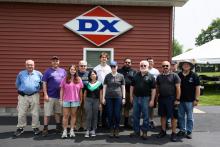HamSCI Field Work at K3LR
HamSCI Field Work at K3LR

A Successful Field Exercise
HamSCI just completed its first ever multi-day field exercise, where two components of the Personal Space Weather Station (PSWS) were successfully installed at the world-class ham station K3LR in West Middlesex, PA. Students, professors, research associates and community volunteers were hosted for four days by station owner Tim Duffy, K3LR.
The field exercise had three goals: a) installation of a PSWS ground magnetometer and a WSPR Daemon/RX888 wide band SDR and an active antenna; b) exposure to ham radio and practical applications of the applied physics which make HF communication possible; c) a chance for all attendees, including invited members of the ham community from western PA and eastern Ohio, to enjoy Tim’s special brand of hospitality, including an afternoon operating the K3LR station.
Timeline of Events
Much of the installation work and computer setup was done on Monday evening and Tuesday morning, including assembly of a DX Engineering active vertical receive antenna, insertion of an 8-foot ground rod/antenna mounting point, digging a hole for, and then burying the HamSCI/TAPR designed ground magnetometer (built prior to arrival at Scranton), followed by laying cables between the equipment and the building housing the equipment.
It was “show time” on Tuesday afternoon, when the RX888 spectrum display was fired up. That effort included a Zoom session with HamSCI “spectrum consultant” Rob Robinette, AI6VN. Rob declared the 1-30 MHz spectrum at K3LR, as displayed on the WSPR Daemon/RX888’s waterfall display, to be very clean, with a good opportunity to be one of the top spotters, worldwide, of WSPR signals. This came as little surprise to K3LR, as Tim has spent nearly 40 years perfecting his station, studying the surrounding topography (which, he explained, can greatly influence HF signal paths) and doggedly pursuing and removing every RF noise source in the immediate area. More distant sources, impossible to disable (i.e. commercial AM broadcasters) are well known to Tim, and sure enough, they and their mixing products were observed on the HamSCI equipment. Some tuning and tweaking of the RX888 bandwidth, along with a judicious choice of input filters, left the RX888 happily receiving WSPR and FT8 spots numbering in the hundreds per hour.
Wednesday morning was a two-hour tour of the K3LR antenna farm, with detailed explanations of what, why and how nearly every system functioned. It took two hours because K3LR has 14 towers, 50+ antenna systems (including band-dedicated receiving systems) all designed to eke out every last 0.1 dB of signal when working stations in Europe, Asia and the rest of the globe. The adjective ‘impressive’ doesn’t do it all justice. Consider that two of the towers, each over 200 feet tall, are on aviation maps, painted and lighted to comply with FAA regulations.
Beyond the Work
The week wasn’t all work and no play. Tim and a CWRU alum supplied all the afternoon and evening meals, set up under a large tent, next to the ‘DX Barn’ where some of the male participants overnighted. (The females had a nearby house to themselves). Local caterer Guy Gibbs cooked up piles of chicken, corn on the cob, hamburgers, salads, veggie dishes and all the fixings. Tim and co-host Amy, N8AMY, topped that all with servings of locally made apple pie on Thursday evening. Tim’s friends from the local area, schools and colleges joined the HamSCI bunch to swap operating stories and to discuss HamSCI’s research efforts, mixed with the nerdy banter always heard at ham radio-centric events.
Tim’s hospitality extended to his award-winning ham station, where he invited all in for a tour and operating session. The most recently licensed hams in the group were given seats on four different bands, and paired up with experienced ops in case of questions - and to keep things legal - FCC rules, you know ;-) Over 400 QSOs (contacts) were made on 10, 15, 20 and 40 meters, domestic and DX QSOs with New Zealand, Australia, England, to name a few. Often the stations we worked told us “you are the only signal on the band” and “thanks for the past contest QSOs”. Tim has millions of contacts in his log, going back to 1972, from one of the best known callsigns in the world. Tim credits the success of his station to uncompromising engineering, meticulous maintenance, and a crew of operators dedicated to being the best at what they do. (One particular operating highlight was the brand-new ham we met on 10 meters - it was his very first ham radio contact - and he emailed Tim right afterwards to thank him).
There were other events, almost too numerous to mention. A Monday evening dinner at the local country club, Wednesday evening presentations on HamSCI research topics, N8AMY’s special hot dogs and onions, magnetometer calibration and alignment, breakfasts at the local diner. Perhaps we can reconvene at Tim’s place next year, bringing along another generation of new hams, ready for deep immersion into the wonders of ham radio.
A Hearty Thank You
In summary, a hearty thanks to all who participated, a most enjoyable four days, and we can’t say enough about the support and enthusiasm from station designer/builder/operator Tim Duffy K3LR, and the company he runs, DX Engineering. DXE is a longtime supporter of HamSCI, and we thank them for providing supplies and expertise, helping make the field work highly successful. We are looking forward to gigabytes of data being generated from West Middlesex, PA!
Photos courtesy of Nathaniel Frissell W2NAF (University of Scranton, HamSCI Lead), Gary Mikitin AF8A (author), Harry Bloomberg W3YJ (University of Pittsburgh)
Dr. Nathaniel Frissell, W2NAF, can be seen discussing the field work event on the Q5 Worldwide Ham Radio YouTube podcast, recorded in August, 2025.
